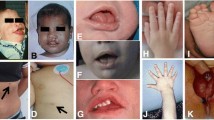Abstract
Alopecia–contractures–dwarfism mental retardation syndrome (ACD syndrome; OMIM 203550) is a very rare genetic disorder with distinct features. To our knowledge, there have been four cases documented to date. In addition, another three patients, previously described as having IFAP syndrome (OMIM %308205), may also have ACD syndrome. We report on one patient with short stature, total alopecia, ichthyosis, photophobia, seizures, ectrodactyly, vertebral anomalies, scoliosis, multiple contractures, mental retardation, and striking facial and other features (e.g. microdolichocephaly, missing eyebrows and eyelashes, long nose, large ears) consistent with ACD syndrome. Results of laboratory testing in the literature case reports were normal, although in none of them, array-CGH (microarray-based comparative genomic hybridization) analysis was performed. In conclusion, the combination of specific features, including total alopecia, ichthyosis, mental retardation, and skeletal anomalies are suggestive of ACD syndrome. We propose that children with this syndrome undergo a certain social pediatric protocol including EEG diagnostics, ophthalmological investigation, psychological testing, management of dermatologic and orthopedic problems, and genetic counseling.


Similar content being viewed by others
References
Boente M, Bibas-Bonet H, Coronel AM, Asial RA (2000) Atrichia, ichthyosis, follicular hyperkeratosis, chronic candidiasis, keratitis, seizures, mental retardation and inguinal hernia: a severe manifestation of IFAP syndrome? Eur J Dermatol 10:98–102
Cambiaghi S, Barbareschi M, Tadini G (2002) Ichthyosis follicularis with atrichia and photophobia (IFAP) syndrome in two unrelated female patients. J Am Acad Dermatol 46:S156–S158
Celli J, Duijf P, Hamel BCJ, Bamshad M, Kramer B, Smits AP, Newbury-Ecob R, Hennekam RCM, van Buggenhout G, van Hearingen A, Woods CG, van Essen AJ, de Waal R, Vriend G, Haber DA, Yang A, McKeon F, Brunner HG, van Bakhoven H (1999) Heterozygous germline mutations in the p53 homolog p63 are the cause of EEC syndrome. Cell 99:143–153
Centre for Applied Genomics (2005) Database of genomic variants, version 13 December 2005. http://projects.tcag.ca/variation/. Accessed 17 December 2007
Dumic M, Cvitanovic M, Ille J, Potocki K (2000) Syndrome of short stature, mental deficiency, microcephaly, ectodermal dysplasia, and multiple skeletal anomalies. Am J Med Genet 93:47–51
Eramo LR, Burton Esterly N, Zieserl EJ, Lee Stock E, Herrmann J (1985) Ichthyosis follicularis with alopecia and photophobia. Arch Dermatol 121:1167–1174
Hamm H, Meinecke P, Traupe H (1991) Further delineation of the ichthyosis follicularis, atrichia, and photophobia syndrome. Eur J Pediatr 150:627–629
Happle R (2004) What is IFAP syndrome? Am J Med Genet 124A:328
Johns Hopkins University (2007) Online Mendelian Inheritance in Man (OMIM). http://www.ncbi.nlm.nih.gov/sites/entrez?db=OMIM. Accessed 17 December 2007
Keyvani K, Paulus W, Traupe H, Kiesewetter F, Cursiefen C, Huk W, Raab K, Orth U, Rauch A, Pfeiffer RA (1998) Ichthyosis follicularis, alopecia, and photophobia (IFAP) syndrome: clinical and neuropathological observations in a 33-year-old man. Am J Med Genet 78:371–377
Klopocki E, Neumann LM, Tonnies H, Ropers HH, Mundlos S, Ullmann R (2006) Ulnar-mammary syndrome with dysmorphic facies and mental retardation caused by a novel 1.28 Mb deletion encompassing the TBX3 gene. Eur J Hum Genet 14:1274–1279
König A, Happle R (1999) Linear Lesions reflecting lyonization in women heterozygous for IFAP syndrome (ichthyosis follicularis with atrichia and photophobia). Am J Med Genet 85:365–368
Martino F, D’Eufemia P, Pergola MS, Finocchiaro R, Celli M, Giampà G, Frontali M (1992) Child with manifestations of dermotrichic syndrome and ichthyosis follicularis-alopecia-photophobia (IFAO) syndrome. Am J Med Genet 44:233–236
Mégarbané H, Zablit C, Waked N, Lefranc G, Tomb R, Mégarbané A (2004) Ichthyosis follicularis, alopecia, and photophobia (IFAP) syndrome: report of a new family with additional features and review. Am J Med Genet 124A:323–327
Priolo M, Lagana C (2001) Ectodermal dysplasias: a new clinical-genetic classification. J Med Genet 38:579–585
Schinzel A (1980) A case of multiple skeletal anomalies, ectodermal dysplasia, and severe growth and mental retardation. Helv Paediat Acta 35:243–251
Van Gelderen HH (1979) Syndrome of total alopecia, multiple skeletal anomalies, shortness of stature, and mental deficiency. Am J Med Genet 13:383–387
Acknowledgments
We sincerely thank the patient and his family for participation in this study. We are also grateful to M. Wetter for performing the chromosome and subtelomere analyses, R. Ullmann and the Max-Planck-Institute of Molecular Genetics, Berlin, for providing the BAC array for array-CGH analysis, Wellcome Trust Sanger Centre and BACPAC Resources Centre for providing the BAC clones, as well as K. Wagner, M. Bihler, and F. Trotier for their technical assistance. This work was supported by the Else Kroener-Fresenius Foundation.
Author information
Authors and Affiliations
Corresponding author
Rights and permissions
About this article
Cite this article
Schell-Apacik, C., Hardt, M., Ertl-Wagner, B. et al. Expanding the phenotype of alopecia–contractures–dwarfism mental retardation syndrome (ACD syndrome): description of an additional case and review of the literature. Eur J Pediatr 167, 1057–1062 (2008). https://doi.org/10.1007/s00431-007-0641-6
Received:
Revised:
Accepted:
Published:
Issue Date:
DOI: https://doi.org/10.1007/s00431-007-0641-6




